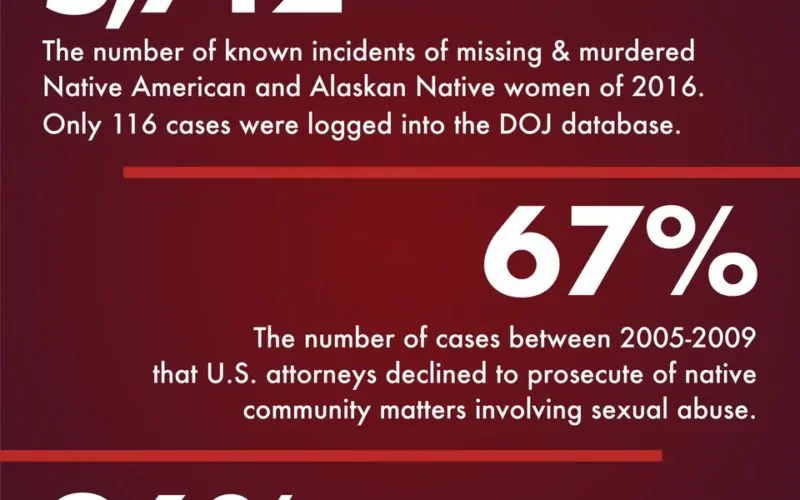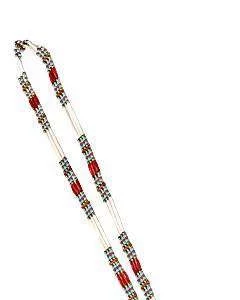Females of all ages in Indigenous communities are more prone to becoming victims of sex trafficking.
In 2015, research found that an estimated 40 percent of women who are victims of sex trafficking identify as American Indian, Alaska Native, or First Nations. And these numbers are lower than reality if you take into account girls and women who are never found and those who do not report.
According to the NCAI Policy Research Center:
Communities that experience the following characteristics should be on alert for the presence of human and sexual trafficking:
- Historical trauma and cultural loss
- Significant poverty and/or economic isolation/dependence
- High rates of Adverse Childhood Experiences in the population
- High numbers of homeless and runaway youth
- High rates of family surveillance and involvement with child welfare system
- High rates of exposure to violence (direct and/or indirect, through domestic, intimate partner violence)
- High rates of personal or family/caregiver addiction to substances
- Low levels of police or law enforcement presence
- Influx of a transient, cash-rich workforce
In the article by The Guardian entitled ‘Nobody saw me': why are so many Native American women and girls trafficked?, the author follows teenage sisters Eva and Haley (names have been changed for protection) and their horrific story of years of sexual abuse, poverty, neglect, and for Eva—many months of exploitation and sex trafficking from a young man she had believed actually loved her.
With Eva, it all started when she was just 12 years old and her grandmother bought her a cell phone. The phone became the gateway to her nightmare, as she began and share intimate photos and videos with the man she had met on social media who claimed to know her from school. His name was ‘D’.
D’s influence on Eva began to show; she was stealing her grandmother’s car to go see him, would drink and smoke with him, and was sneaking around and lying to her family. This may sound like somewhat of a typical teenage tale, but things got worse for Eva.
The intimate photos between Eva and D suddenly became forced upon her and the type and intensity of the actions that were recorded and photographed were much more sexual and violent. Then one day, Eva got raped by D and his brother and cousin. After that encounter, she was often transported to have sex with strange men. For the next few years, threats were made to Eva that if she did not do what D wanted, he would harm her and her family.
Eva finally got out. She was arrested a few times, went missing once, has moved several times—but now her and her sister Haley are safe. They are both enrolled in school and doing much better than they were.
This shocking story of a young girl’s struggle in the sex trafficking world is one of reality. Similar events are happening throughout North America and especially in Native communities. Girls and women are not safe.
What can we do about this?
One of the best things you can do is become more knowledgeable on the signs of someone who is being sex trafficked and of communities that are more susceptible to it.
The U.S. Department of State describes “key red flags” that individuals should look for to discover a human trafficking situation. Some key red flags include “poor living conditions,” “inability to speak to individual[s] alone,” “answers appear to be scripted and rehearsed,” “signs of physical abuse,” and “under [eighteen] and in prostitution” to name a few.
But only looking out for signs isn’t good enough—because once these signs are apparent, this means that something has already begun to happen.
If you are interested in understanding this issue on a deeper level or would like to help or advocate, here are a few organizations the average person get involved with to make a difference.
- The National Indigenous Women’s Resource Center
- Joy Smith Foundation
- The National Judicial Council
- US Chamber of Commerce
PowWows.com also touches on the tragedy of missing and murdered Indigenous women (MMIW). The article describes the issue more in detail with shocking and interesting statistics to go along with it. The article also goes into detail about ways we can all do our part to put a stop to the horrific treatment of Indigenous women and girls.
Communities and the nation as a whole need to take this issue seriously and act. Girls and women cannot wait any longer. The time is now.
Last Updated on October 3, 2023 by vhormazabal




Lou
says:So, why aren’t these women in the DOJ data base? Because, they are too busy being weaponized for political injustices!!!!
Elton Michael
says:Wrong. This all started long before a certain white crybaby politician and fraud started pandering that bs to the gullible.
AND if you actually bothered to READ the article huge percentages go unreported